 J Clin Aesthet Dermatol. 2021;14(4):E53–E60.
J Clin Aesthet Dermatol. 2021;14(4):E53–E60.
by Hilary E. Baldwin, MD; Lawrence J. Green, MD, FAAD; Leon Kircik, MD; Eric Pierre Guenin, PharmD, PhD, MPH; Anya Loncaric Forest, MS; and Radhakrishnan Pillai, PhD
Dr. Baldwin is with the Acne Treatment and Research Center in Brooklyn, New York, and Rutgers Robert Wood Johnson Medical Center in New Brunswick, New Jersey. Dr. Green is with the Department of Dermatology at George Washington University School of Medicine in Washington, DC. Dr. Kircik is with the Indiana University School of Medicine in Indianapolis, Indiana; Physicians Skin Care, PLLC, in Louisville, Kentucky; and the Icahn School of Medicine at Mount Sinai in New York, New York. Dr. Guenin is with Ortho Dermatologics in Bridgewater, New Jersey. Ms. Forest and Dr. Pillai are with Bausch Health US, LLC in Petaluma, California.
FUNDING: This study was sponsored by Ortho Dermatologics.
DISCLOSURES: Dr. Baldwin has served as advisor, investigator, and on the speakers’ bureaus for Almiral, Cassiopea, Foamix, Galderma, Ortho Dermatologics, Sol Gel, and Sun Pharma. Dr. Green has served as investigator, consultant, or speaker for Almirall, Cassiopea, Galderma, Ortho Dermatologics, Sol Gel, Sun Pharma, and Vyne. Dr. Kircik has acted as an investigator, advisor, speaker, and consultant for Ortho Dermatologics. Dr. Guenin is an employee of Ortho Dermatologics and may hold stock and/or stock options in its parent company. Ms. Forest and Dr. Pillai are employees of Bausch Health US, LLC, and may hold stock and/or stock options in its parent company. Bausch Health US, LLC is an affiliate of Bausch Health Companies Inc. Ortho Dermatologics is a division of Bausch Health US, LLC.
CORRESPONDENCE: Hilary Baldwin, MD; Email: hbaldwin@acnetrc.com
Clinical Trials ID: NCT02938494
ABSTRACT: Background. In a Phase II study, tazarotene 0.045% lotion was statistically superior to vehicle and comparable to tazarotene 0.1% cream in reducing acne lesions, with fewer treatment-related adverse events (TEAEs) than the cream.
Objective. We analyzed data from the aforementioned study post-hoc to evaluate the effects of sex on treatment outcomes.
Methods. Participants aged 12 years or older with moderate-to-severe acne were randomized to tazarotene (0.045% lotion or 0.1% cream) or vehicle (lotion or cream) for 12 weeks of double-blind treatment. Outcomes analyzed in male and female subgroups included changes from baseline in inflammatory/noninflammatory lesions and TEAEs.
Results. In the intent-to-treat population (94 males and 116 females), reductions in lesion count were greater with tazarotene (lotion or cream) than with vehicle. In participants receiving tazarotene 0.045% lotion, the least-squares mean percent changes from baseline to Week 12 were greater in females than males, but the differences were not statistically significant (inflammatory [?70.3% vs. ?56.2%]; noninflammatory [?60.0% vs. ?53.2%]). In both females and males, the TEAE incidence was lower with tazarotene 0.045% lotion than 0.1% cream.
Conclusion. Tazarotene 0.045% lotion substantially reduced acne lesions in both female and male participants. This newest tazarotene formulation might benefit patients who cannot tolerate older formulations or other topical retinoids. Given the relatively small size of this study, however, the results of this post-hoc analysis are intended to be exploratory in nature.
KEYWORDS: Retinoid, acne, sex, topical, gender
Acne affects an estimated 85 percent of adolescents and young adults1,2 and appears to be increasing in prevalence among adults, particularly in women.3,4 Males and females have different cutaneous physiologies and treatment needs, which may need to be considered when recommending an acne regimen. For example, male patients tend to have greater sebum production (especially at younger ages), lower transepidermal water loss, and lower pH values than female patients.5,6 Female patients may be more likely to suffer from persistent or recurrent acne, have flare ups associated with monthly hormonal fluctuations, and experience psychosocial distress, which can trigger behaviors (e.g., picking) that contribute to sequelae such as postinflammatory hyperpigmentation and scarring.4,7,8
For most patients with acne, topical retinoids are recommended as a key component of the treatment regimen.2,9 However, the utility of efficacious formulations may be limited by a higher incidence of side effects, including dryness, irritation, peeling, and erythema.2 To address this issue, a novel lotion formulation was developed for tazarotene, a retinoid that is currently approved in the United States at a 0.1% concentration for the treatment of acne and which is available as a gel, cream, or foam. This new lotion formulation of 0.045% tazarotene, which uses less than half the concentration of 0.1% tazarotene, was developed using a polymeric emulsion technology. This results in a more uniform distribution of the active ingredient and hydrating excipients at the skin’s surface, providing an aesthetically pleasing, highly spreadable lotion (Figure 1). 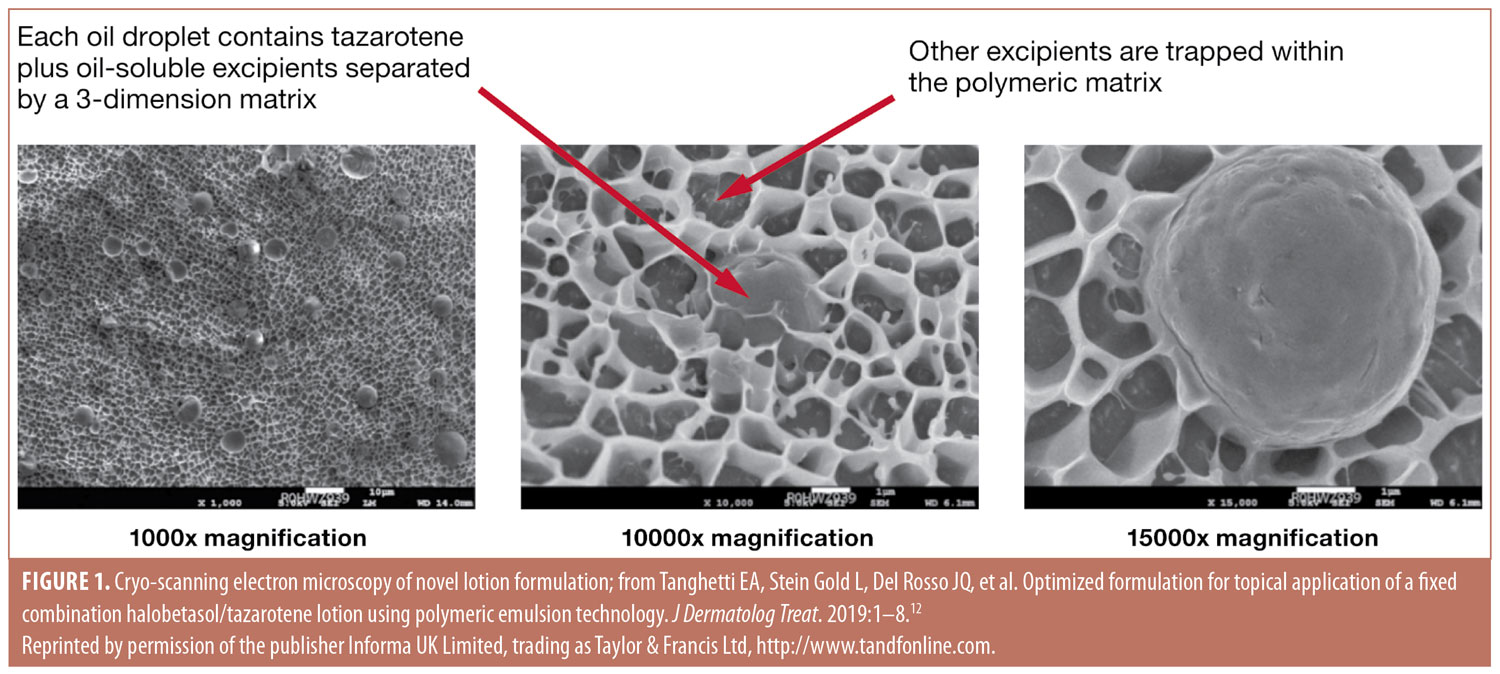
In a 12-week, randomized, double-blind, Phase II trial (NCT02938494), tazarotene 0.045% lotion was superior to vehicle in reducing both inflammatory and noninflammatory lesion counts in adolescents and adults with moderate-to-severe acne.10 After 12 weeks, inflammatory and noninflammatory lesion counts were decreased by 63.8 and 56.9 percent, respectively, with statistically significant differences from vehicle (reductions of 51.4% and 35.2%, respectively; p<0.01, both). As compared with the higher-concentration tazarotene 0.1% cream, the tazarotene 0.045% lotion had comparable efficacy but notably fewer adverse events. To better understand the potential effects of sex on acne outcomes, data from this Phase II trial were analyzed to evaluate the efficacy and safety of tazarotene 0.045% lotion in male and female participants.
Methods
Study design. This was a post-hoc analysis of data from a Phase II trial, for which detailed methods have been published.10 Briefly, male and female participants with moderate-to-severe acne vulgaris, aged 12 years and older, were randomized (2:2:1:1) to receive 12 weeks of double-blind treatment with tazarotene 0.045% lotion (approved for acne; Ortho Dermatologics), tazarotene 0.1% cream (approved for acne; Allergan, Inc.), vehicle lotion, or vehicle cream. All participants were required to have an Evaluator’s Global Severity Score (EGSS [also known as the Investigator’s Global Assessment]) rating of “moderate” (score=3) or “severe”(score=4) at screening and baseline. Participants applied study medication to the face once daily in the evening.
Assessments. Data from male and female participants were analyzed post-hoc to evaluate the following: 1) mean absolute changes from baseline to Week 12 in inflammatory and noninflammatory lesion counts; 2) mean percent changes from baseline in inflammatory and noninflammatory lesions by study visit (Weeks 4, 8, and 12); 3) percentage of participants with treatment success at Week 12, defined as at least a two-grade reduction from baseline in EGSS score and a rating of “clear” or “almost clear”
(score=0 or 1); 4) mean changes from baseline to Week 12 in the Acne-Specific Quality of Life Questionnaire (Acne-QoL) and; 5) incidence of treatment-emergent adverse events (TEAEs). Vehicle groups (lotion and cream) were combined (“combined vehicle”) for these analyses.
Statistical analysis. Statistical comparisons (tazarotene 0.045% lotion versus combined vehicle, tazarotene-treated male versus female participants) were conducted as follows: analysis of covariance with treatment as a factor and baseline lesion count as a covariate for mean changes from baseline to Week 12 in absolute lesion counts; and Cochran–Mantel–Haenszel test for treatment success at Week 12. No statistical comparisons were made between tazarotene 0.045% lotion and tazarotene 0.1% cream. The last observation carried forward was used to impute missing data for changes in lesion counts and treatment success. All Acne-QoL and TEAE data were analyzed descriptively, with no imputation for missing values and no comparisons between treatment arms or between male and female participants. All statistical processing was performed using SAS version 9.3 or later (SAS Institute, Cary, North Carolina).
The study protocol, informed consent form, other information provided to participants, and all appropriate amendments for the original Phase II study were properly reviewed and approved by the governing Institutional Review Board (Veritas IRB, Inc., Montreal, Quebec, Canada). The study was conducted in accordance with the ethical principles originating from the Declaration of Helsinki, International Conference on Harmonization guidelines, and Good Clinical Practice guidelines and in compliance with local regulatory requirements. Written informed consent was obtained from participants or their legal guardians prior to participation in the study; participants younger than the age of consent signed an assent form.
Results
Participants. The intent-to-treat (ITT) population included 210 participants (n=94 males; n=116 females). At baseline, mean inflammatory lesion counts were generally similar across treatment groups in both males and females, with no apparent differences between the sexes (Table 1). For noninflammatory lesions, the mean counts at baseline were somewhat higher in males who were randomized to tazarotene (lotion or cream) and in females who were randomized to vehicle, respectively. Few participants in any treatment group had an EGSS rating of “severe” (score=4) at baseline, but the percentage was somewhat higher in males (9.6%) than females (6.0%). Males and females had similar mean baseline scores for the acne symptoms domain of the Acne-QoL; however, females tended to have lower (worse) mean scores for the self-perception, role-emotional, and role-social domains.
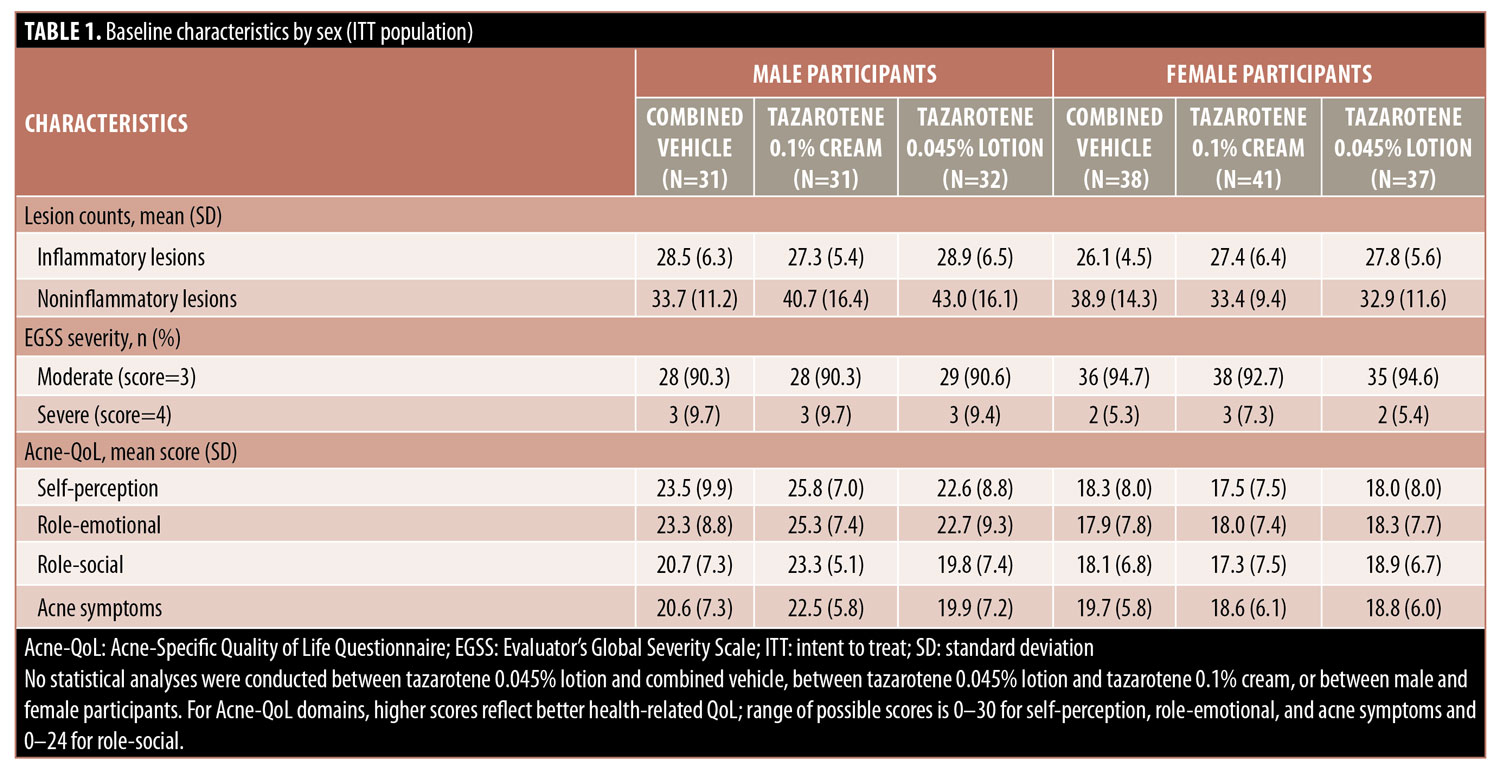
Efficacy and QoL. The least-squares mean decreases from baseline to Week 12 in absolute lesion counts were greater with tazarotene 0.045% lotion versus combined vehicle in both male and female participants. Results for inflammatory lesions were trending but not statistically significant in males (?16.5 vs. ?13.8; p=0.212) and were significant in females (?18.8 vs. ?14.8; p<0.05). Results for noninflammatory lesions were significant in both males (?21.6 vs. ?12.0; p<0.01) and females (?20.8 vs. ?14.8; p<0.05).
Statistical analyses for mean percentages in lesion counts were not conducted, but some possible trends were observed. For inflammatory lesions, mean percent changes by study visit in the male subgroup were generally similar across treatment arms, with decreases of ?48.7 percent (combined vehicle), ?52.9 percent (tazarotene 0.1% cream), and ?56.5 percent (tazarotene 0.045% lotion) recorded at Week 12 (Figure 2A). In the female subgroup, a separation between the active treatments and combined vehicle was apparent starting at Week 8, with decreases of ?53.6 percent (combined vehicle), ?65.4 percent (tazarotene 0.1% cream), and ?70.1 percent (tazarotene 0.045% lotion) recorded at Week 12 (Figure 2B).
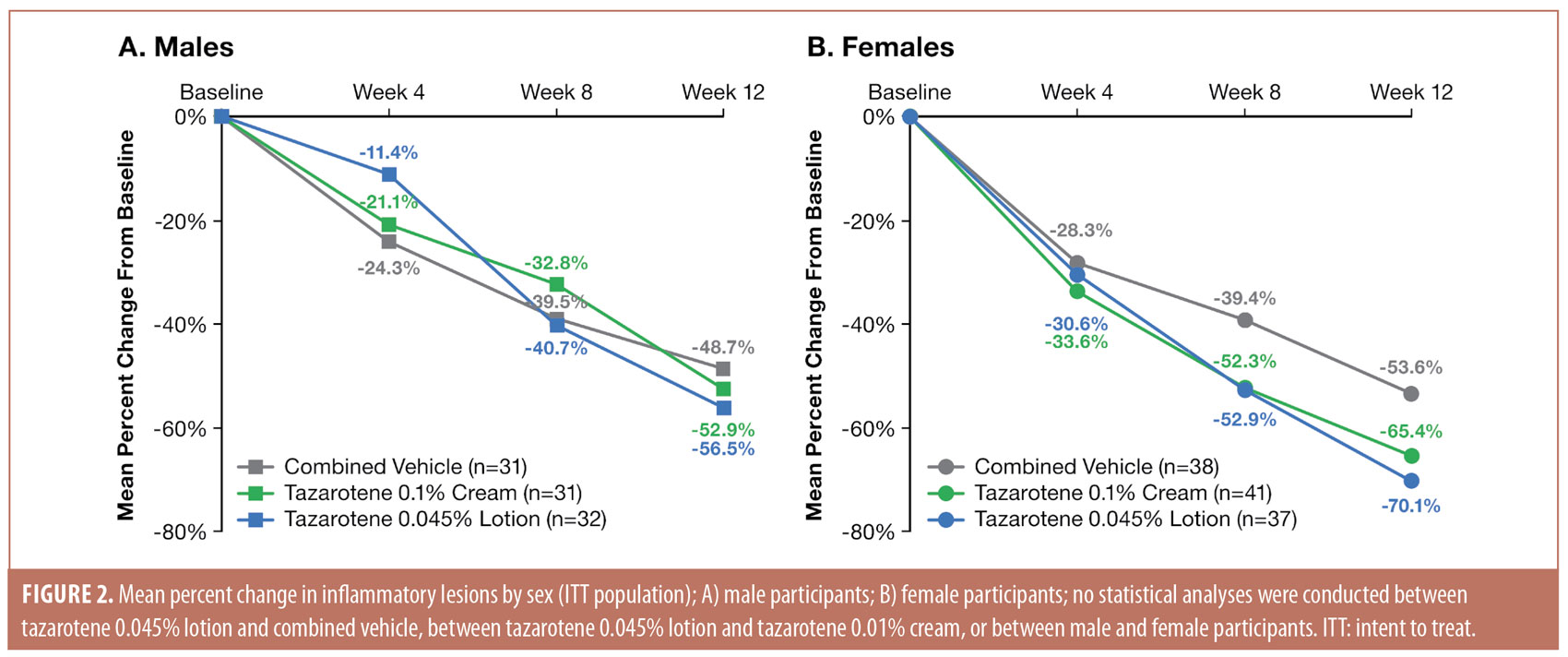
For noninflammatory lesions, a separation between active treatment (tazarotene lotion or cream) and combined vehicle was apparent from Week 4 through Week 12 in both male and female participants (Figure 3). However, this separation was larger in males than in females, possibly due to the smaller decreases with combined vehicle in males.
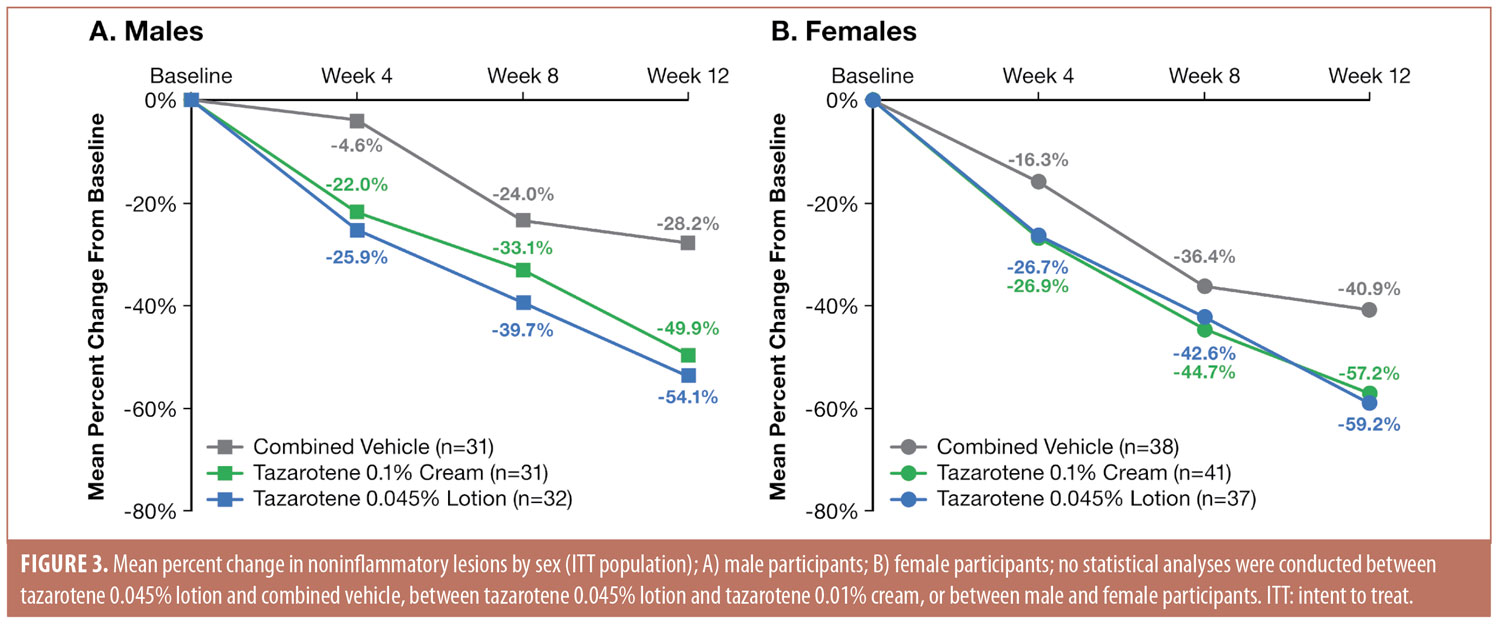
In participants who were randomized to tazarotene 0.045% lotion, least-squares mean percent changes by study visit indicated that female participants generally had greater improvements in inflammatory skin lesions than male participants, with a significant difference at Week 4 (?30.1% vs. ?11.9% for males; p<0.05) but not at Week 12 (?70.3% vs. ?56.2%) (Figure 4A). For noninflammatory lesions, the pattern of improvement was more similar between females and males, with no significant difference between subgroups at any visit including Week 12 (?60.0% vs. ?53.2%) (Figure 4B).
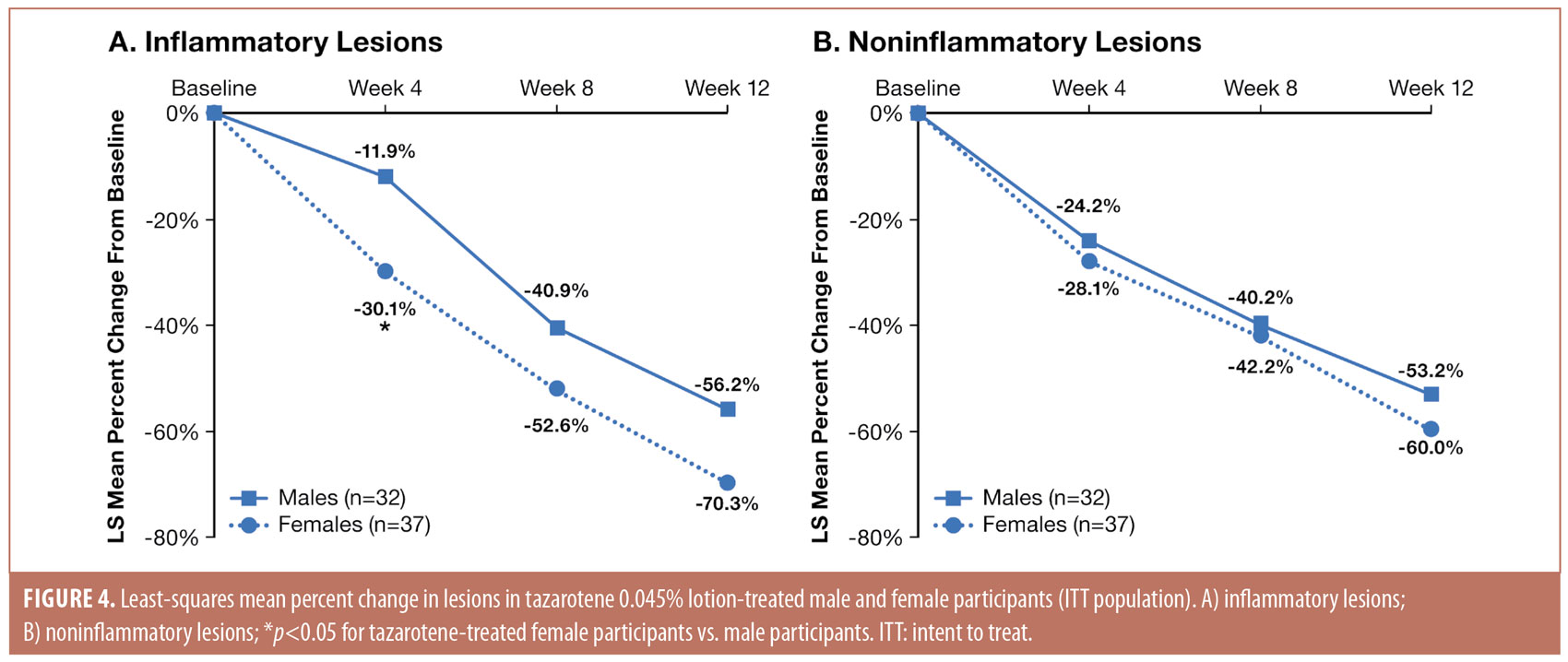
The percentage of participants with EGSS treatment success at Week 12 was higher with tazarotene 0.045% lotion versus combined vehicle in both males and females; however, differences between treatment and vehicle were not statistically significant (Figure 5). As compared with male participants, a higher percentage of female participants achieved treatment success at Week 12 with tazarotene 0.045% lotion (24.3% vs. 12.5%) and tazarotene cream (19.5% vs. 12.9%), but these differences were not statistically significant.
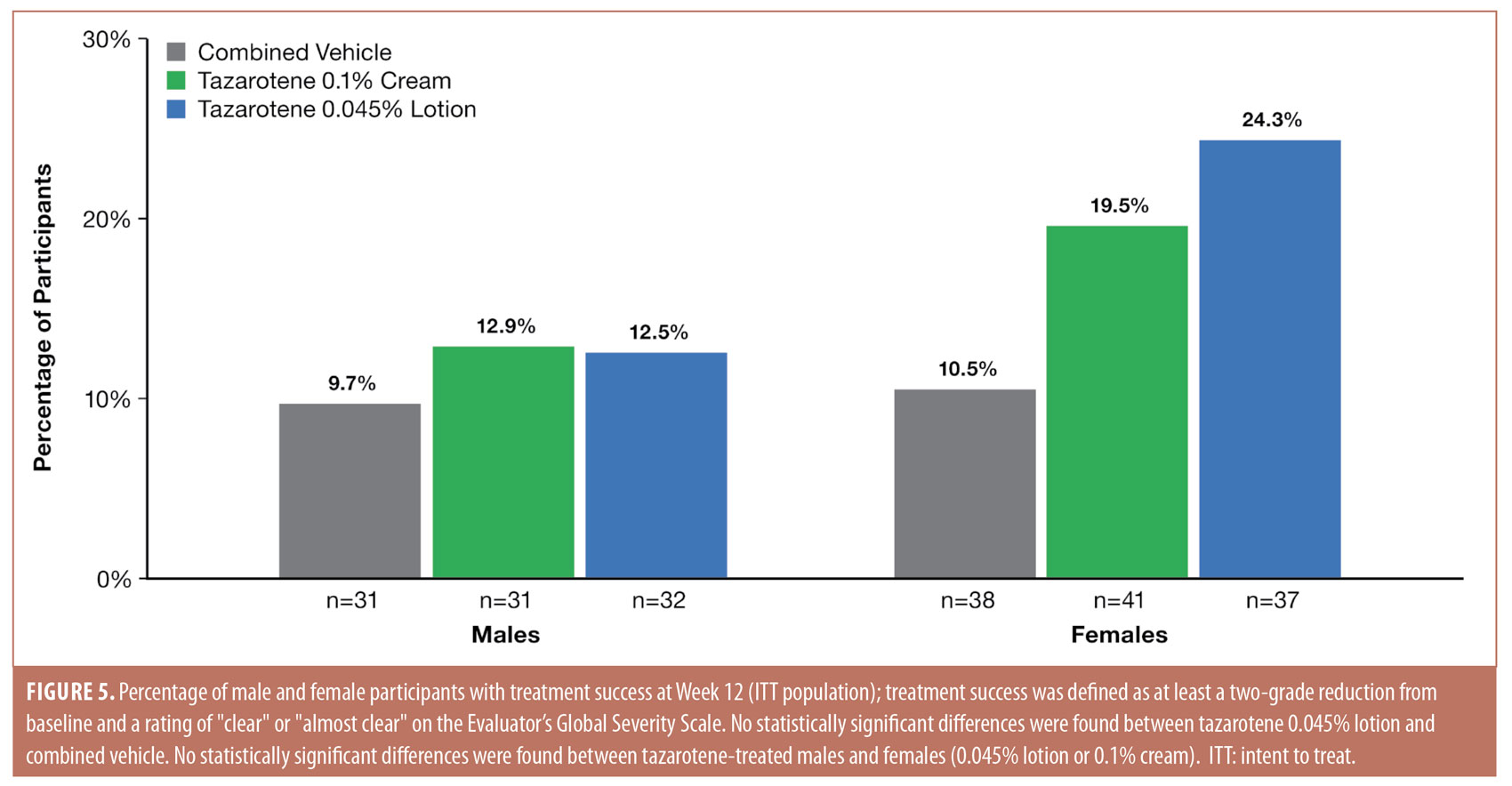
Overall, both males and females had mean improvements from baseline to Week 12 in all four Acne-QoL domains (Table 2). Female participants tended to have lower (worse) Acne-QoL scores at baseline than male participants (Table 1). However, females treated with tazarotene 0.045% lotion had greater mean improvements from baseline to Week 12, resulting in mean scores at Week 12 that were comparable between tazarotene 0.045% lotion-treated males and females, as follows: self-perception (28.0 vs. 28.2), role-emotional (26.9 vs. 27.7), role-social (23.5 vs. 25.0), and acne symptoms (26.6 vs. 26.2) (Table 2).
Safety. TEAE rates with active treatment (tazarotene lotion or cream) were higher in males than in females, while TEAE rates with combined vehicle were similar between males and females (Table 3). However, the incidence of any TEAE was lower with tazarotene 0.045% lotion than with tazarotene 0.1% cream in both males (19.4% vs. 30.0%) and females (10.8% vs. 24.4%). No participant in any treatment group had a serious adverse event (SAE); only a few participants discontinued due to a TEAE (one male with tazarotene 0.1% cream) or had a severe TEAE (one male and one female with tazarotene 0.045% lotion). TEAEs were mostly judged as unrelated to treatment, with the exception of those in four females who received tazarotene 0.1% cream and two participants (1 male, 1 female) in the tazarotene 0.045% lotion group.


Discussion
The level of evidence for tazarotene and other retinoids for treating acne is strong,2 but these therapies have also been associated with irritation, peeling, erythema, and dryness.11 To address the ongoing need for an effective topical retinoid treatment with better tolerability, polymeric emulsion technology was used to develop a novel lotion formulation of tazarotene.12 With this technology, tazarotene is encapsulated within oil droplets along with moisturizing and hydrating ingredients. These oil droplets are evenly dispersed in an oil-and-water emulsion and are held apart by the three-dimensional polymeric mesh matrix. This allows for uniform placement of the oil droplets on the skin. With this technology, tazarotene may be delivered at a lower and potentially less irritating concentration than currently available foam, gel, and cream formulations.13–16
Promising results for the novel tazarotene 0.045% lotion were demonstrated in a randomized, double-blind, vehicle-controlled, Phase II trial that included adolescents and adults with moderate-to-severe acne. In this study, treatment with tazarotene 0.045% lotion resulted in significantly greater symptom improvements relative to with vehicle, with a lower incidence of TEAEs compared to that recorded with use of tazarotene 0.1% cream.10 Since male and female patients might have different responses to acne treatment,8,17 a post-hoc analysis was conducted in study participants by sex. The results of this analysis indicate that tazarotene 0.045% lotion was effective in reducing acne symptoms in both male and female participants.
At Week 12, there were no statistically significant differences between males and females for clinician-assessed treatment outcomes (i.e., lesion counts and EGSS treatment success). However, there were some trends that suggest possible sex-related effects in participants who were treated with tazarotene 0.045% lotion. At Week 12, the female subgroup had a larger mean percent reduction in inflammatory lesions (?70.1% vs. ?56.5% for males) and noninflammatory lesions (?59.2% vs. ?54.1%), as well as a higher rate of treatment success (24.3% vs. 12.5%) than in the male subgroup (Figures 2 and 3); a similar pattern was also found with tazarotene 0.1% cream. Although none of the comparisons between males and females were significant at Week 12 for tazarotene 0.045% lotion (Figure 4), reductions in inflammatory lesions at Week 4 were significantly greater in females than in males (?30.6% vs. ?11.4%; p<0.05), suggesting a more rapid onset of treatment effect in this subgroup. In the absence of long-term follow-up, however, it is unknown whether these female participants would have continued to experience a better treatment effect in inflammatory lesions than male participants, or if the male participants would have eventually had similar outcomes with more time on treatment.
Treatment duration is not the only factor to consider when interpreting any potential differences between males and females in this post-hoc analysis. Another point worth noting is that female participants experienced a larger magnitude of improvement in lesion counts with combined vehicle compared to male participants. For example, female participants had a mean percent reduction of ?40.9 percent in noninflammatory lesions with combined vehicle compared with that of ?28.2 percent in male participants at Week 12. Consequently, the separation between tazarotene 0.045% lotion and combined vehicle was smaller in females than in males, suggesting a potentially smaller overall treatment effect. However, there were also differences between males and females at baseline that might have contributed to these results. Mean noninflammatory lesion counts at baseline were modestly higher in male participants randomized to tazarotene (lotion or cream) and in female participants randomized to vehicle, which may have allowed more room for improvement with tazarotene in males and with vehicle in females. Other potential factors that may need to be considered when interpreting results from this analysis include: differences between males and females in terms of dermatologic physiology (e.g., sebum production), patient age (e.g., postmenopausal women or adolescent males), treatment adherence, and disease type (i.e., new onset, recurrent, or persistent).4–8
Acne affects the quality of life of patients of all ages. The psychosocial effects of acne can include self-consciousness and decreased social interaction in adolescents, difficulty with intimacy in younger adults, and feelings of disempowerment in older adults.18 Acne also affects quality of life in both male and female patients, although studies indicate that adult women might experience the greatest impact.3,4 In this study, mean improvements in all four Acne-QoL domains were found in both males and females (Table 2). Consistent with the literature, female participants tended to have lower (worse) Acne-QoL scores at baseline. However, they also had greater improvements than males with active treatment (tazarotene 0.045% lotion or 0.1% cream), particularly in the domains of self-perception, role-emotional, and role-social. These improvements resulted in mean scores at Week 12 that were comparable between males and females for tazarotene 0.045% lotion. Notably, females also experienced Acne-QoL improvements with vehicle (lotion or cream), suggesting that formulations themselves might have properties, such as moisturization, that can be beneficial to female patients. Much more research is needed to better understand which specific Acne-QoL items are the most important for quality-of-life improvements in males and females. Until then, determining patient formulation preferences (i.e., gel, cream, lotion, or foam) might be an important step toward improving patient satisfaction with treatment and medication adherence.
To help patients understand potential differences between formulations, a discussion about tolerability can be helpful. The novel lotion formulation in this study was specifically developed to deliver a lower concentration of tazarotene that would improve tolerability without compromising efficacy. Overall, few participants in this study discontinued due to a TEAE or had severe TEAEs and no participant had any SAEs (Table 3). However, both males and females had a lower overall incidence of TEAEs with tazarotene 0.045% lotion compared to tazarotene 0.1% cream (males: 19.4% vs. 30.0%; females: 10.8% vs. 24.4%), suggesting that this novel formulation appears to have a better tolerability profile than the approved cream formulation. This improved tolerability might be especially important for women, who are more likely to experience dryness and irritation from topical acne treatments.17
Limitations. Several key limitations of this post-hoc analysis should be noted. First, the study was not designed to compare outcomes in male and female participants and any interpretation of differences between subgroups should be taken with caution. Second, given the relatively small size of this study, the results of this post-hoc analysis are intended to be exploratory in nature, though a recent post-hoc analysis from two Phase III studies has confirmed these findings in male and female participants.19 The findings of this Phase II study might be more suited to raising additional questions for further research than providing concrete treatment recommendations. To that end, future analyses with larger populations might help to elucidate whether any additional factors beyond sex (e.g., age, race, disease severity) need to be considered when treating patients with tazarotene 0.045% lotion. Finally, the generalizability of these results is limited by the study itself, which was designed to evaluate 12 weeks of treatment in participants with moderate or severe acne. Based on the original study and this post-hoc analysis, no conclusions can be drawn about the long-term effects of tazarotene 0.045% lotion on acne or about the treatment effects in patients with milder forms of acne. However, this lotion formulation does appear to be an effective treatment option for both male and female patients with acne, on par with or numerically better than the higher concentration 0.1% cream formulation that is currently approved in the United States for acne.
Conclusions
Results of this post-hoc analysis indicate that once-daily treatment with tazarotene 0.045% lotion for 12 weeks was well tolerated and effective versus combined vehicle in reducing inflammatory and noninflammatory lesion counts in both male and female participants with acne. There were no significant differences in efficacy between males and females and both sexes showed improvements in QoL with tazarotene treatment, although female participants tended to have larger QoL improvements. Taken together with the improved tolerability of tazarotene 0.045% lotion relative to higher concentration tazarotene 0.1% cream,10 this newly developed moisturizing lotion formulation is a viable treatment option in male and females with acne.
Acknowledgments
Medical writing support was provided by Mildred Bahn, MS, and Lynn M. Anderson, PhD (Prescott Medical Communications Group, Chicago, Illinois) with financial support from Ortho Dermatologics.
References
- Lynn DD, Umari T, Dunnick CA, Dellavalle RP. The epidemiology of acne vulgaris in late adolescence. Adolesc Health Med Ther. 2016;7:13–25.
- Zaenglein AL, Pathy AL, Schlosser BJ, et al. Guidelines of care for the management of acne vulgaris. J Am Acad Dermatol. 2016;74(5): 945–973.e933.
- Skroza N, Tolino E, Mambrin A, et al. Adult acne versus adolescent acne: a retrospective study of 1,167 patients. J Clin Aesthet Dermatol. 2018;11(1):21–25.
- Bagatin E, Freitas THP, Rivitti-Machado MC, et al. Adult female acne: a guide to clinical practice. An Bras Dermatol. 2019;94(1):62–75.
- McCarty M. Evaluation and management of refractory acne vulgaris in adolescent and adult men. Dermatol Clin. 2016;34(2): 203–206.
- Keaney TC. Male acne: the importance of gender in acne treatment. Cutis. 2013;91(4):167–168.
- Zeichner JA, Baldwin HE, Cook-Bolden FE, et al. Emerging issues in adult female acne. J Clin Aesthet Dermatol. 2017;10(1):37–46.
- Dreno B, Bagatin E, Blume-Peytavi U, et al. Female type of adult acne: Physiological and psychological considerations and management. J Dtsch Dermatol Ges. 2018;16(10):1185–1194.
- Zaenglein AL. Acne vulgaris. N Engl J Med. 2018;379(14):1343–1352.
- Tanghetti EA, Kircik LH, Green LJ, et al. A phase 2, multicenter, double-blind, randomized, vehicle-controlled clinical study to compare the safety and efficacy of a novel tazarotene 0.045% lotion and tazarotene 0.1% cream in the treatment of moderate-to-severe acne vulgaris. J Drugs Dermatol. 2019;18(6):542.
- Leyden J, Stein-Gold L, Weiss J. Why topical retinoids are mainstay of therapy for acne. Dermatol Ther (Heidelb). 2017;7(3):293–304.
- Tanghetti EA, Stein Gold L, Del Rosso JQ, et al. Optimized formulation for topical application of a fixed combination halobetasol/tazarotene lotion using polymeric emulsion technology. J Dermatolog Treat. 2019:1–8.
- Feldman SR, Werner CP, Alio Saenz AB. The efficacy and tolerability of tazarotene foam, 0.1%, in the treatment of acne vulgaris in 2 multicenter, randomized, vehicle-controlled, double-blind studies. J Drugs Dermatol. 2013;12(4):438–446.
- Smith JA, Narahari S, Hill D, Feldman SR. Tazarotene foam, 0.1%, for the treatment of acne. Expert Opin Drug Saf. 2016;15(1): 99–103.
- Jarratt M, Werner CP, Alio Saenz AB. Tazarotene foam versus tazarotene gel: a randomized relative bioavailability study in acne vulgaris. Clin Drug Investig. 2013;33(4):283–289.
- Shalita AR, Berson DS, Thiboutot DM, et al. Effects of tazarotene 0.1 % cream in the treatment of facial acne vulgaris: pooled results from two multicenter, double-blind, randomized, vehicle-controlled, parallel-group trials. Clin Ther. 2004;26(11):1865–1873.
- Thiboutot DM, Dreno B, Abanmi A, et al. Practical management of acne for clinicians: An international consensus from the Global Alliance to Improve Outcomes in Acne. J Am Acad Dermatol. 2018;78(2 Suppl 1):S1–S23 e21.
- Nguyen CM, Beroukhim K, Danesh MJ, et al. The psychosocial impact of acne, vitiligo, and psoriasis: a review. Clin Cosmet Investig Dermatol. 2016;9:383–392.
- Kircik LH, Gold LS, Beer K, et al. Once-daily polymeric tazarotene 0.045% lotion for moderate-to-severe acne: pooled phase 3 analysis by sex. J Drugs Dermatol. 2020;19(8):777–783.

